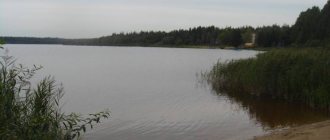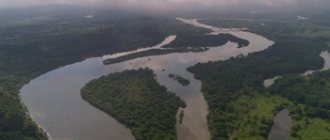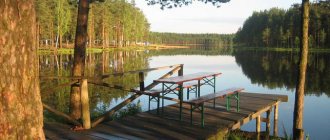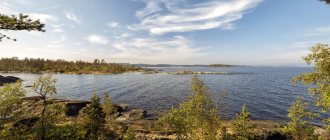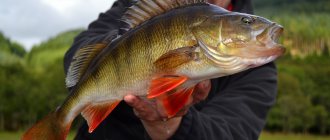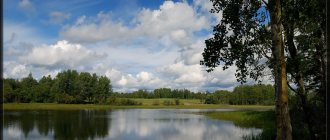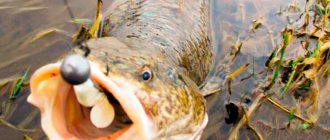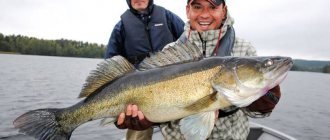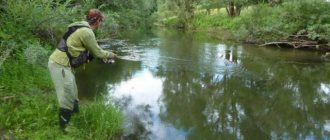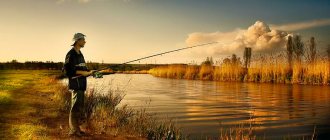Fishing in the Leningrad region and Karelia has its own specifics and features, which, naturally, it will be difficult to say anything about in a “nutshell”. Therefore, the purpose of this material is to provide as detailed information as possible about the specifics of fishing in the above-mentioned regions of the Russian Federation.
The best places for fishing in the Leningrad region
It would be logical to start this material with which bodies of water in the Leningrad region are suitable for fishing. By the way, there are quite a lot of them.
In addition, it should be noted that there are much more artificial ponds than, for example, rivers, where you can also go fishing well, the main thing is to know “in what place” and “for what bait”, because each of the “aquatic” inhabitants has its own weaknesses and preferences for baits.
Rivers
And although, according to statistical data, the number of rivers in the region is quite small, it is still possible to identify several rivers that are popular among fishing enthusiasts:
- Izhora is a river surrounded by meadows and a lot of bushes, giving it the appearance of a not very well-groomed river. In parallel to this minor disadvantage, it is noted that the fauna includes a significant number of fish such as roach, pike and perch. As an addition, it would be foolish not to note that a lot of famous fishermen consider the village of Skvoritsy to be the most promising place for fishing;
- Stormy - a river with a rather funny name never ceases to delight fishermen with its beauty and good catch. The inhabitants of these waters are fish such as trout, burbot, perch and pike;
- The Neva is a well-known fauna, which is often remembered in folk songs. In addition to the great length of the reservoir, it should be noted that it flows into the Baltic Sea (through the Gulf of Finland). The Neva has become a “home” for bream, pike perch and perch (they are the most active).
Lakes
Regarding this type of reservoir, one can talk and tell a lot for a long time, but it will be at least stupid, because it would be more radical to outline only those lakes where fishing is the most fruitful:
- Mirror is a lake that received its name for a reason, because its water is quite clean, and in some places even transparent. In addition to the beautiful nature, here you can catch roach, perch and ruff in a relatively short period of time;
- Pionerskoye is a lake in the Leningrad region, near which a camp for children was once located (hence the name). Today, this lake is a real paradise for fishermen, because in practice it has been proven that fishing on the lake can bring a good catch: bleak, perch, bream. According to professionals, the best catches were recorded in the area of the village of Ryabovo;
- Roshchinskoye is a lake located in the village of Torfyanoe, Leningrad region. Regarding fishing, sources claim that this artificial reservoir accommodates burbot, crucian carp and tench.
Paid reservoirs
Today, almost every region of the Russian Federation has lakes and ponds, the visit of which is paid. Naturally, the main purpose of such “visits” is fishing, but now, in addition to it, on the territory of the base you can spend the night in a hotel, have a nice dinner in a restaurant, or rent a boat or motorboat.
In order to make this question a little more specific, here is a list of the most famous paid places for fishing:
- Monetka is a very popular base, which includes a small hotel with 8 beds, the opportunity to rent a boat, breakfast/lunch/dinner. As for the reservoir itself, during fishing, carp bite well, the weight of which can reach 10 kilograms;
- Dobroye is a fishery farm located an hour’s drive from the regional center. It is one of the largest fishing grounds in the region. Around the territory of incredible beauty there is a coniferous forest, a restaurant, several cottages and even swimming pools, which are often used by visitors, especially in the summer. The waters of the pond are inhabited by such inhabitants as crucian carp, carp, bream and silver carp;
- Quiet Backwater is a name from a very fruitful and beautiful place where citizens from all over the region often fish, naturally, not for free. While staying at the base, you can rent a boat, buy gear and even bait. Trout and carp are the main “residents” of the reservoir, which most often act as a catch for visiting fishermen.
Best places
To begin with, it should be noted that the following reservoirs received the title of “best” places for fishing not by chance, but only after a detailed analysis of a wide range of reviews from fishermen who pay tribute to the following places:
- Vuoksa is a river with a rather strange and incomprehensible name, located in the Leningrad region. The river's waters include pike perch, bream, whitefish, ide and even salmon;
- The Gulf of Finland is a bay where fishing is advisable only in cloudy weather. According to fishermen, bream, pike perch, roach and perch bite very well;
- Volkhov is a river where it is recommended to fish exclusively in the summer, and from a boat, because many people say that even long-term fishing from the shore can be fruitless. You can most often catch zander and pike in the middle of the river.
Prices. The pricing policy for fishing at the above-mentioned places and many others is very different. In some places you can do some good fishing for 500 rubles (half a day), and somewhere for 3,000 rubles (a day). Much in this matter depends on the range of services provided, living conditions and the availability of fish species.
Rules. As for the rules, they did not begin to include anything new: do not argue on the territory of the bases, do not throw bait based on chemical additives into the water, do not remove from the base an amount of fish not agreed with its management.
All about fishing in the Leningrad region in November
November is a great month for fishing. Fans of open water fishing and those who respect ice fishing also enjoy the bite.
In good weather, before freeze-up, they use spinning rods and mugs for fishing. After the first frost, small lakes and ponds are covered with thin ice. You can start fishing from ice only when its thickness reaches 5 cm. Let’s take a closer look at how and what kind of fish to catch in November, how fishing in November differs from fishing in other autumn months.
Beginner fishermen need to know that fishing in November can be divided into three periods, each of which is characterized by its own characteristics:
- fishing in November before the ice freezes;
- fishing directly during ice cover;
- fisherman on the first ice.
It should be noted that the timing of ice formation for water bodies in the central zone of the European part of Russia is almost the same, with the exception of the northern regions, where freeze-up in some years is observed even in the last ten days of October, and the southern regions, where it usually occurs in the first half of December. In some years, the southern reservoirs of the Krasnodar Territory do not freeze at all, and successful fishing continues in November in open water. In the Kuban, vimba and shemai are well caught with bottom rods; predatory fish take lures and live bait. We will find out how to fish in each of the indicated periods, what gear to use and what kind of fish to expect.
Fishing in November before freeze-up In the first ten days of the month there is constant rain, sometimes with wet snow, and when it clears, frosts occur. During this period, fishing is not much different from fishing in October. The angler's calendar for November notes that, if the weather is favorable, fishing with spinning rods and mugs continues until freeze-up in November. Fishing with mugs gives good results in November, but at low temperatures it is difficult and requires thorough physical preparation. In November, in good weather, fishing with float rods continues for perch - for fry and roach - for bloodworms (preferably in lakes). Fishing in November during freeze-up days In the first days of freeze-up, fish usually take throughout the day. Pike perch bite better in the early morning and in the evening, before dark. Fishing is most successful on cloudy, calm days with low temperatures. You need to start fishing in ponds, lakes and backwaters of large bodies of water. Fishing in November on the first ice After freeze-up, fish are caught from morning to evening. More successful fishing is in relatively warm, cloudy and calm weather. Almost all types of fish can be caught well with winter sports gear on the first ice:
- In November, fishing with large winter lures is good for pike perch, pike perch, and large perch;
- In November, medium-sized perch is caught with small spoons; it is better to catch it at shallow depths near sunken snags and grass, using a worm or bloodworm as bait;
- Fishing in November with a jig with a bloodworm attachment gives excellent results - this way you can catch perch and roach;
- In November, using winter float rods at depths with a slight current, you can catch bream, chub, roach, silver bream, perch, dace, and gudgeon.
- They use winter live bait rods to catch pike in November; fishing will be more successful if you fish in deep places, and it is better to use ruff, perch or crucian carp as live bait.
- fishing in November for burbot is more effective with bottom fishing rods at night; it is better to fish with ruff or small roach;
- Fishing in November during fishing - all types of fish, except pike and pike perch, at shallow depths with a smooth current;
- In November, pike perch, large perch, and pike come to the girders from the depths.
Fishing in November is possible with both winter and summer gear. This month is a transitional stage from open water fishing to ice fishing. Large rivers and reservoirs, despite the low air temperature, remain ice-free.
Water has a high heat capacity and it takes some time for it to cool throughout its entire thickness. In November, in such water bodies (large rivers, bays, reservoirs) the height of fishing for predatory fish is in full swing. The greatest interest this month is pike fishing.
The pike have an autumn feeding period, which in its intensity can only be compared with the pre-spawning period. In November, pike can be caught with a float rod using live bait, with mugs, and by trolling, but the most exciting and exciting is fishing with a spinning rod. Any bait is suitable for catching pike in November, the main thing is that they should be larger. Pike is preparing for winter, which is why it is especially attracted to large prey. The most suitable bait is a spinner; you can also catch pike with a vibrating tail. But catching pike with live bait may not live up to expectations. But if the pike reacts reluctantly to a live but inactive fish, it responds perfectly well to a dead one. You can catch pike at the end of autumn using both regular spoons and large bright balancers in white, yellow and green colors. Less popular among fishermen are the brick-red balancers, but they say that the fish also go for them, but generally don’t pay attention to the silver ones. The best time for pike fishing in November is the first morning hours. There are chances to catch fish before sunset. Fishing for pike during the day is almost a waste of time. As already mentioned, fishing for perch in November can take place both in open water and on the first, not yet thick ice. The main thing to remember is that in November the perch have already gathered in fairly large schools and are staying at depth. At this time, it is most effective to catch it with small wobblers, which sink better, using jerking movements of various animations. Also at this time, the use of jig equipment justifies itself, but since at this time the water becomes quite transparent, jig heads are equipped with rubber baits of dark or natural colors. Fishing in November for perch using spinners can also bring results, but it is not as effective as in August or September. When going fishing for perch in November, keep in mind that perch is a diurnal predator, so catching it is possible throughout the day. Of course, the most promising time for catching perch in November is early morning and evening, it is believed that it is during these periods of time the perch is most active. Fishing for perch in November is most effective on relatively warm days, with steady or gradually increasing atmospheric pressure and a slight wind from the south or west. It is very interesting to catch pike perch in November. Unlike pike, it actively moves in search of prey and rarely lies in ambush. Fishing in November for pike perch is more effective at depth, where it gathers in schools and either looks for wintering holes or hunts. Also, pike perch can almost always be found in places where small items accumulate. Fishing for pike perch in November is more successful in the evening or in the morning; pike perch is not particularly active during the day. Many fishermen fish for pike perch exclusively at night. The most popular way to fish for pike perch in November is to catch pike perch with a jig. The baits themselves should be of medium size, color does not matter. To catch pike perch with jig bait, several types of fishing are used. Namely, stepped and smooth, the pike perch prefers when the bait moves quickly; it is not attracted to slow retrieval. Pike perch can also be caught using oscillating spoons. In addition, many fishermen catch pike perch in November using donka. Donka is mainly thrown when fishing for pike perch at night. Tackle for pike perch must be strong, since in November pike perch is almost always caught in large sizes: a strong fishing line and a metal leash are your faithful helpers. November is the month when burbot is caught purposefully. Fishing in November for burbot is more successful in its feeding areas at night stops for small fish. Also, as the water gets colder, burbot begins to visit the coastal zone. Burbot does not like areas where the bottom is covered with dense vegetation or silt. The best places where burbot fishing is most successful are considered to be those where pebble rifts or sandstones are followed by holes about 2 meters deep without a current. Fishing for burbot in November occurs at night and all bites occur after sunset. As for the gear in November, you can successfully use ordinary donks with a 0.3 mm fishing line and a sliding sinker. Hooks use single hooks of the first number, and a leash with a diameter of 0.25 mm is required. In November, the best bait for this predator is live bait. Most fishermen believe that the best live bait is the ruffe or gudgeon, since these fish, like burbot, lead a bottom-dwelling lifestyle and do not cause him to be particularly wary of their presence in his hierarchy. In addition to live bait, you can use frogs, in this case you need to follow one rule: you need to hook such bait by hooking it on the back paw. Fishing for crucian carp in November is very dependent on the weather, because the November crucian carp is already beginning to lose activity and gradually settles down for the winter at the bottom. Fishing for crucian carp in November is more successful when the water warms up, that is, during the day and on days with rising temperatures. In warm water, crucian carp is more active. Since with the onset of cold weather crucian carp loses activity due to a decrease in metabolism, it is best to refuse bait, mainly due to the fact that crucian carp moves only in very limited spaces in November. When fishing for crucian carp, the main thing to remember is that crucian carp are not active in November, and there is no need to play with the bait. It's best to leave it motionless. And remember that you need to recast if it doesn’t bite for a long time. The best rod for catching crucian carp in November is a light one, about 4.5 -5 meters long. A telescopic rod is quite suitable, as they are quite long and light. The float must be sensitive so that its slightest movement can be noticed, because fish are not particularly active in November, and you need to pay the slightest attention to the movement of the float. For fishing in November for crucian carp you should use hooks No. 2.5-3.5.
With the arrival of November, bream begin to group at depths near the pits in which they spend the winter. Fishing in November for bream near the rocks, where the depth starts almost from the shore, or from a boat will be effective. Remember that in November bream mainly stays at medium and deep depths; the bottom prefers a clay or rocky bottom; it is better not to choose a sandy bottom. In November, the bream bite does not begin in the morning; the fish become active around 10 o'clock, but the bite is steady and continues throughout the day with varying success. Of the gear, the most promising in November will be either a feeder or a regular donka with a feeder. A three-meter rod for catching bream in November will be sufficient; it will allow you to cast to the distance you need. It is better to use bloodworms or maggots as bait in November. as well as a sandwich made from them. Don’t forget about the mastyrka, a very catchy bait when fishing for bream. It is prepared from split or round peas, which are boiled for several hours (until the water has completely boiled away), mixed with semolina or corn flour and cooked for a few more minutes. Honey, sunflower oil and a little vanillin are added to the finished homogeneous mass.
Finding roach in November is not difficult. The favorite places for roaches are quiet bays with depths of more than a meter, not heavily silted and overgrown. Fishing in shallow holes near steep banks is very promising; it will be a plus if there are trees on the shore leaning towards the water. Very often, roaches are found on the borders of reed thickets with clear water. Fishing for roach in November is more successful if you use sensitive gear. A lightweight rod 6 meters long is equipped with a 0.08 mm fishing line. The float should also be light, with a load capacity of up to 0.4 grams. Catching roach in November is more successful if you give preference to animal baits. Basically, at this time, dung worms, bloodworms, various larvae or maggots are used. Moreover, you can use maggots that have already pupated. Good fishing for shell meat. It has been noticed that roach react very actively to a moving bait, so many fishermen slowly play along with the bait after casting, which brings good results. The composition of bait for fishing for roach in November is simple: breadcrumbs, fried ground rolled oats, cake and dried daphnia (aquarium food).
1. ROSHINSKOE LAKE Coordinates: 60.802268, 29.951003 How to get there: Otradnoye railway station. Further - on foot. It is more convenient to get here by car through the village of Torfyanoe at the northern end of Komsomolskoye Lake or through the village of Krasnoarmeyskoye on its western shore.
What to catch: There are 8 small islands on the lake. The banks are heavily overgrown and fishing is preferable from a boat, but you can cast a fishing rod and spinning rod from the mountainous shore. The lake is rarely visited by fishermen, since it can only be reached by car. The access to the lake is good, close to the water. But you need to look for them. Here you can find: perch, roach, pike, bream, burbot, crucian carp, tench.
2. VUOKSA RIVER Coordinates: 63.504304 N 27.94004 east
How to get there: Distance from St. Petersburg along the highway - 95 km. The nearest railway stations: Losevo and Gromovo.
Who to catch: Fishing on Vuoksi is possible all year round. Here you can catch pike, salmon, trout, pike perch, ide, chub, and whitefish. Vuoksa is especially popular among spinners and fly fishing enthusiasts. In the channel between Lake Virta and Lake Suvanto there are trout and salmon. The second place that attracts fishermen is Taipolen-Ioki. In addition to trout and salmon, pike perch, pike, and lake trout are caught here in the summer.
3. MIRROR LAKE Coordinates: 60.225990, 29.124574 How to get there: How to get there: by car you can get to the lake along Primorskoye Highway to the village of Zelenaya Roshcha, then turn right to Yappilya station. If you are traveling on your own, take the train to the same station.
Who to catch: on the lake you can fish both from the shore and from the islands - with bottom fishing rods, and from a boat - with a spinning rod, an onboard fishing rod, circles. In spring you can successfully hunt for roach in the northern part of the lake. In summer, deep holes near the islands will be good places to catch bream and perch. The only negative is that there are a lot of tourists.
4. GULF OF FINNISH Coordinates: 59.995882, 29.696652 How to get there: If you decide to try your luck in the dam area, then take a bus, minibus or your own transport to Kronstadt.
Who to catch: The Gulf of Finland is famous for its fresh waters thanks to the rivers flowing into it. A number of fish species live here. Most of all, fishermen like the areas of Primorsk, Vyborg, the northern and southern dams. It is best to fish in the bay in cloudy weather. The main places for catching pike perch are Repino, Zelenogorsk, and Resort. Fishing in the Gulf of Finland and adjacent rivers and canals is almost always successful. Bream, pike-perch, roach and perch are caught on donkeys and feeders.
5. SMALL AND MIDDLE NEVKA Coordinates: 59.982455 N 30.254307 east
Who to catch: Fishing can be especially good in the morning and evening. But it is not recommended to fish here in the spring. Using a donkey baited with processed cheese, a chub is caught. At the mouth of the Bolshaya Nevka at night they catch silver bream, rudd, ide, and bream on the bottom. The most interesting place: 3 Elagin Bridge.
How to get there: for example, by metro to Krestovsky Island.
6. LAKE LADOGA Coordinates: 59.958897, 31.034274 How to get there: To catch pike and pike perch, take the train to Petrokrepost station. 3 kilometers away is the village of Koshkino: experienced fishermen promise that you won’t leave here empty-handed.
Who to catch: Over 50 species of fish live in Ladoga. Villages and settlements are located all along the coast, and avid fishermen are frequent visitors. For example, the village of Kobona is loved by winter fishing enthusiasts. The catch of Ladoga perch, pike perch and roach is practically guaranteed at any time of the year.
7.VOLKHOV RIVER Coordinates: 59.073484 N 31.770609 east
How to get there: By train from Moskovsky station in the direction of Malaya Vishera. The drive is more than two hours. Another option is a car.
Who to catch: You'll find some great fishing from a boat. From the shore it is also possible, but in certain sections of the river. In the middle of the river there are deep holes where large fish are kept. It is possible to catch considerable pike and pike perch with considerable probability. If luck smiles, you will catch catfish, ide and chub. A great place to sit with a bottom fishing rod on a boat or on the shore is a place near the Volkhov-Most station and in the Novaya Ladoga area.
8. RIVER SVIR Coordinates: 60.481920, 32.905779.
How to get there: To Volkhov. And then by rail to Pasha or along the P21 highway.
Who to catch: The Svir is considered the most fishy river in the southwest of the region. The best period for fishing is when the water recedes and oxbow lakes form - places of the old riverbed. In the waters of the Svir there are various fish: catfish, rudd, and pike. You can fish on the Svir from the shore, or in floods by boat. You can fish throughout the entire body of water, but there are certain places where fishing is especially good, such as the mouth.
9. IZHORA RIVER Coordinates: 59.607750, 30.196158 How to get there: If you decide to try your fishing luck in this reservoir, you need to get to the Mozino railway station. Here you can fish both down and up the river.
Who to catch: Izhora flows at a distance of 30 kilometers from St. Petersburg. Along the entire river there are small pikes, burbots, and roaches. In Izhora there are a lot of “runaway” trout from the Gatchina nursery. Trout is caught by fly fishing or spinning in the evening or early in the morning. It is good to catch it in cloudy weather.
10. OREDEZH RIVER Coordinates: 59.345676, 30.184925.
How to get there: from Gatchina by minibus and a little more on foot. Another option is by personal transport.
Who to catch: Oredezh - a river flows from a medium-sized reservoir on the Izhora Upland.
In its sources there are a lot of trout and grayling. The largest trout are caught in Chikinsky Pond. Trout and pike live there. The best time for fishing is evening or early morning. Description of the place:
The recreation center "Yunga" on Lake Krasnoflotskoye in the Vyborg district of the Leningrad region can become one of your favorite places for eco-vacation, since the lake, although quite large, is not without a certain comfort and natural intimacy. Lake Krasnoflotskoye is for fishery purposes,… Read more
Description of the place:
The Luga River basin has a different climate.
In the southern region, where it is much warmer, you can find catfish and asp fish. This fish will be an excellent trophy for any fisherman, both experienced and novice. In this river you can catch pike perch, bream, roach, catfish, eel, and lamprey. From the Gulf of Finland during... More Description of the place:
The ideal time for fishing is early spring, after the ice has melted.
Make sure the water temperature reaches 18-19 degrees. It is during this period that ide begins to appear. The best catches are observed in the channels between lakes Khvoylovo and Antonovo. Typically, ide bites on the larvae of burdock moths, but closer to... More Description of the place:
White Lake is located on the territory of the Leningrad region, in the city of Gatchina.
According to certain data, this reservoir is of artificial origin and was formed in the 1760-1790s. due to the reconstruction of the dam on the Teplaya River. White Lake is located on the territory of the Gatchina Museum-Reserve,... More Description of the place:
Since most of the coastal zone is overgrown, fishing on the Vrude River from the shoreline is difficult in some areas.
However, the exceptional beauty of the area, the rare purity of the waters, and the picturesque landscapes did not leave the fishermen indifferent. Along the entire length of the river there are tent camps and bases... More Description of the place:
The Oyat River in the Leningrad region has many fishing spots where the catch is especially successful.
Every year, numerous fishing enthusiasts come to the river to relax in company. On Oyat, fishing is possible using spinning rods, donkeys, fly fishing and float fishing. For people who like to combine... More Description of the place:
Fishing on the Mga River depends on the depth and width of the reservoir.
The values vary in different parts of the waterway, which determines the nature of fishing. At the upper part, the width of the river reaches six meters, the depth is about a meter. The bottom is viscous. The coastline is low, ... More Description of the place:
The Izhora River in the Leningrad region, located 30 km south of St. Petersburg, is one of those rivers that can be traced from the very source.
It is now generally accepted that Izhora originates from a spring located in the Gatchina region near the village of Skvoritsy, but previously it was believed that it begins... More Description of the place:
Sister is a river in the Leningrad region, which originates in the swamps of the Lembolovskaya Upland, and flows into to Sestroretsky Razliv.
Its length is 85 kilometers, the depth varies along its entire length. At the source the Sestra is shallow, with many fords. The depth of the upper and middle... More Description of the place:
The Leningrad region is rich in water resources.
The Svir River is unique, connecting two lakes rich in fish, Ladoga and Onega. Thanks to the interweaving of two reservoirs, the fish world is diverse, and fishing on the Svir is a real pleasure. More details Description of the place:
The picturesque lake Voronino is located next to the island.
Polyakovsky. The reservoir is small, its length is only 0.7-0.8 km, width 0.5-0.6 km. The banks are swampy, covered with mixed forest, dominated by alder, birch, spruce, and only on the north-eastern side is the bank steep and elevated, not far from which... More Description of the place:
The second name is Bolshaya Vereshnya.
The lake is located among low hills covered with forest. It is located approximately 3 km south of Lake Spas-Kotor. Small: length 1.5 km, width no more than 0.25 km. Despite its small size, the lake is quite deep. The maximum depth in the central… Read more Description of the place:
Lake Vishnevskoye is located between lakes Glubokoe and Pravdinskoye.
The southeastern and northern shores of the lake are most densely populated. Getting to Lake Vishnevskoye is easy - through the village. Pervomaiskoe to the village. Podgorje. Then 1 km in the direction of the village. Krasnoselskoye and further along a good dirt road... More Description of the place:
Lake Volochaevskoye is located south of Lake Vishnevskoye.
The East Vyborg Highway runs 0.5 km west of the lake. The most convenient way to get to the lake is by personal vehicle - from St. Petersburg - through the village. Ogonki, Pervomaiskoe - to the village. Podgorje. Then turn right into the village. Volochaevka... More details Description of the place:
Village.
Veshchevo – 3.5 km, railway Art. Veshchevo – 10 km. There is a good country road to Lake Vestovoye. Mixed forest with a predominance of coniferous species, in some places a raised swamp, overgrown with low pine. A stream flows from Lake Vestovoye into Lake Lamskoye Nizhneye, width up to 5 m, depth about 0.5 m. Fish passage in... More Description of the place:
Lake Voroshilovskoye in Finnish was called Mart-järvi.
Järvi (translated from Finnish) is a lake. Located seven kilometers east of the city of Svetogorsk. From St. Petersburg to the north-west it is approximately 144 km. The lake has an elongated appearance, its length is 101 km, its width is about 900... More Description of the place:
Lake Vysokinskoye is located 12 km southeast of the city of Primorsk.
It is more convenient to get there by personal vehicle - along the Primorskoye Highway to the southern tip of the lake. Or by diesel train from Zelenogorsk to the railway station. Art. Ermilovo and then walk 6 km. The length of Lake Vysokinskoye is about 6 km, the average... More Description of the place:
Fishing lovers have something to do here.
Fishing on Lake Zerkalny attracts many people here who prefer to combine a pleasant holiday and successful fishing. This place is considered one of the most popular among fishermen living in the Leningrad region. Flat surrounding landscape in... More Description of the place:
Narva Reservoir When deciding for yourself where to go fishing in the Leningrad region, pay attention to the Narva Reservoir.
This is a very promising place both for a good rest and for returning home with a decent catch. You can fish both from the shore and out into the open... Read more Recommended bases for fishing and recreation
- Base “Oyat”
- Base “Yuksovo”
Fishing areas in this region
When using the calendar, you must not forget that the bite of fish depends and is determined not only by the calendar dates and biological cycles of their life reflected in the calendar, but also to no less extent by the state of their habitat; the bite also depends on weather conditions: air and water temperature , cloudiness, wind direction and strength, etc. Source: Rarely a fisherman does not consider “Life and Catching Freshwater Fish” by L.P. Sabaneev as his reference book. You can glean a lot of useful information from it. Thus, the “Fishing Calendar” will tell you how this or that fish behaves at different times of the year. Let's take a short trip through this calendar.
January. Burbot spawning begins in central Russia. Before spawning (and during spawning?), burbot continues to take live bait and pieces of fish. In small flowing lakes, fish approach the mouths or springs. Perch stops taking lures and jigs in February. At the beginning of the month, perch in North-Eastern Russia begins to catch fish again - using jigs and ruffs. If there is no thaw, the fish suffocate in small stagnant lakes (Central Russia).
March. In central Russia, it comes out of the holes to the edges of the ice and the mouths of rivers and begins to take live bait (zhor before spawning). The dace also begins to peck, emerging from the holes (before spawning).
April. In central Russia, pike spawning continues or begins. First the small ones play, then the large ones, first in rivers, then in rivers and, finally, in lakes and ponds (semi-flowing). Spawning ends in two to three weeks, sometimes dragging on until the end of the month. In the second half of the month they spawn: first ide (earlier in small rivers), then dace (later in Southern Russia?), in rivers, on coastal sedge - perch (when the ice completely melts and the ice drift stops). The gudgeon in the rivers comes out onto the riffles. When the water begins to recede, spring fishing for burbot in the pits at night with a worm and a bottom fishing rod from a raft or boat. The bite sometimes continues until mid-May. It begins (at the end of the month) to take ide (from the bottom), first small ones, and also roach (before spawning), which around the middle of the month comes out of the holes where it spent the winter.
May. In the middle zone (mostly when the birch tree is blooming) small bream spawn, then around May 9 (during bird cherry blossoms) the medium bream, and around the middle (when the bread is earing) the largest one. Spawning of perch, roach, gudgeon. Zhoring pike after spawning and catching it with a lure and a fishing rod (with live bait). Ruff bite. The gudgeon takes the worm on the rifts and sand. Spring burbot fishing is coming to an end. Towards the middle of the month, bleak begins to take over (before spawning), large perch go into the depths, small and medium ones stay in the grasses. The line begins to take.
June. Chub fishing continues with the May beetle. The bleak takes the fly well (from the surface). The best bite for white bream is from the bottom on a worm and bread near the shore in deep and quiet water. Catching submouth and roach with greens (algae) in the rapids. In the second half, trout move from rivers to streams or stay near springs (in the northwestern and western regions). From the middle, catching ides with a grasshopper (fly fishing, without a float or sinker) in deep and strong places. The bream mostly stops taking the bait. At the end of the month, gudgeon moves from the riffles to deeper places with a sandy bottom and continues to be caught with a worm. In the northern tributaries of the Volga (at the end of the month), fishing (of bream, ide, etc.) for broom (mayfly) begins. In northern rivers, grayling strikes from the middle in the morning and in the afternoon.
None August. In the middle zone there is a good bite on the top of the fly, from the day on the worm, also bream and ide on young oats (in some places) with fly fishing. Roaches sometimes take the worm well. The best fishing on the track.
September. In the north and northwest, salmon spawning begins at the beginning (or middle) of the month. In fast, shallow water, in rocks. Fish (ide, roach, rudd, dace, shereshper, chub, ruff) begin to go to the deepest places and gather in large schools. The pike follows. From the middle of the month the ide stops pecking altogether. The chub takes at depth from the bottom. Roach and dace continue to be caught until the frosts, it is best to fish for bloodworms (and maggots?) from the bottom. Pike feeding also begins in deep places. Fishing with live bait (almost from the bottom) and sometimes with lures. The ruff finally goes into deep holes with a muddy bottom and catches well on worms and bloodworms. Perch also gather in large schools in holes (with a sandy bottom) and take well on fry, spoons and (Sometimes) worms. With the onset of bad weather (bad weather), burbot begins to take hold.
October. Minnows and bleak go into holes with a sandy bottom. Fishing for pike with a spinner and perch with a spinner, worm or jig (crustacean) before freezing of rivers and lakes, later on the ice. Ruff continues to catch bloodworms well.
November. Trout slide into pools and holes. The crucian carp finally gathers for the winter in deep muddy holes or buries itself in the mud. In some places it catches ide on bloodworms under the ice. Catching perch and ruff with jigs. At the end of the month, the burbot bite stops (temporarily).
December. In the second half, perch in the middle and northeastern regions stops taking (until the beginning of February) lures, worms and jigs.
Sources:
- www.fishlovlya.ru
- www.spb.kp.ru
- tvoytrophey.ru
- fishermanspb.ru
The best places for fishing in Karelia
The Republic of Karelia, which borders the Leningrad region, also has many wonderful fishing spots. According to official sources, the number of reservoirs in the Republic has long exceeded the 70 thousand mark (rivers, ponds).
Rivers
Whether fortunately or unfortunately, for some reason there are few rivers in Karelia: about 1-2 thousand. But even this fact cannot prevent fishermen from successfully bringing home solid catches.
Where exactly you can go fishing, you, dear readers, can find out from the following list:
- Shuya is one of the most visited and longest rivers in Karelia (194 kilometers). It is noted that the reservoir is quite deep and includes such inhabitants as perch, bream, roach, pike and trout;
- The Okhta is a river that has very high banks, is surrounded by coniferous forest and has large vegetation. Perch, crucian carp, trout and roach bite well in this pond;
- Chirka-Kem is considered the longest river in the Republic of Karelia, its length reaches 200 hundred kilometers, which cannot be ignored. Grayling, roach, salmon, perch and pike are the most active fish species and can often be brought home as catch.
Lakes
As a percentage, 92% of all water bodies in the republic are lakes, many of which act as brilliant and more than suitable places for fishing.
To make the right choice, pay attention to the range of lakes most suitable for fishing:
- Ladoga is a lake that is considered to be one of the largest in Europe. The artificial pond is inhabited by many inhabitants, more than 50 of them (fish species). If we talk about those inhabitants of deep places that most often become prey for fishermen, then they include such fish as burbot, catfish, ruff, chub and even eel;
- Onega is a very large lake, which is located almost in the very center of Karelia. Fishermen will also have something to do on it, for example, fishing for vendace, pike, whitefish, roach and crucian carp;
- Kosmoozero is a clean and well-groomed lake with an extraordinary name, which causes a lot of discussion among local citizens. While fishing on it, you can observe a good bite of ruffe, perch, roach, whitefish and pike.
Paid reservoirs
Today, no one will be surprised by the fact that many private individuals rent ponds, put fish in them and only then begin to make money from “this”, allowing those same fish to be caught by citizens who love to fish, of course, not for free.
You can get this specific, non-free “pleasure” designed for amateurs at the following tourist centers:
- Riffle is a base located on the bank of the not long but well-groomed Szeged River. Its official portal states that for only 800 rubles (per day, per person), a citizen can take advantage of a whole range of activities: fishing (roach, perch, bream, crucian carp), giving a barbecue, hunting a bear and trying a real Russian bathhouse;
- “At Stepanych’s” is a small base with a symbolic Russian name, which, like the previous one, provides its guests with the opportunity to relax their souls and bodies: from spending time in a Russian bathhouse to fishing for pike, crucian carp, trout and bream;
- Lakhta is a small base called by the name of the village in which it is located - the village of Lakhta. For 5,000 rubles a day, a group of five people can fish freely from morning to night, trying to catch perch and burbot, the most common fish in this reservoir. It is impossible not to note the excellent and very convenient geographical location of the base: just one hour drive from the capital of Karelia - Petrozavodsk.
Best places
It is very difficult to have any discussion on this topic, because in Karelia there are a lot of rivers and lakes that are worthy of being called the best according to one or another criterion
But, be that as it may, against the backdrop of thousands of rivers and lakes, we can highlight the most popular and visited ones:
- Segoozero is one of the very popular reservoirs among fishermen, the settlement of which, by the way, is not free, but you shouldn’t be afraid of this, because according to reviews, the prices are quite reasonable;
- “At Ivanovich’s ” is another base that symbolizes the Russian “spirit”. Here you can fish both in summer and winter, which greatly attracts fishermen who are ready to even pay for “this” pleasure;
- Longasy is a small private area where there is an artificial lake with a lot of fish, the fishing of which, unfortunately, is also not free. Among other things, you can take a steam bath, take part in an excursion, and visit the nearby museum-reserve.
Prices. The cost of visiting the above paid bases and fish farms very often differs from each other. These same differences are easy to explain: the higher the quality of service, the wider the range of services, the higher the daily payment for staying on private territory.
Rules. Fortunately, new rules that would aggravate the rights of the fisherman have not yet been invented; at the moment they are unchanged - do not throw cigarette butts and food waste into the water, do not steal fish from the territory, do not damage the property of the base (sofas, boats, equipment), Do not litter or try to use chemicals as bait that can harm fauna.
What fish can you catch in the Leningrad region and Karelia?
The range of fish species in these regions is quite diverse; it allows every fisherman to get his fill of catching both ordinary carp and sturgeon or eel, which are infrequent guests of fresh waters.
So, after analyzing the mass of sources, we can identify the following species of fish that are “residents” of the fauna of Karelia and the Leningrad region:
- Zander;
- Roach;
- Bream;
- Perch;
- Pike;
- Grass carp (Leno region only);
- crucian carp;
- Asp;
- Mirror carp (only Leningrad region);
- Tench;
- Rudd, smelt (only Leningrad region);
- Grayling;
- Palia;
- Ide (Karelia only);
- Sturgeon;
- Catfish;
- Burbot;
- Gudgeon (Karelia only);
From the above, one can understand that of the dozens of existing species of fish, almost all live both in Karelia and in the Leningrad region, which undoubtedly allows millions of fishermen from all over the country to enjoy both paid and free fishing, in which they can catch the most nor is there a wide range of freshwater inhabitants of the fauna of the above-mentioned regions of the Russian Federation.
Fish biting forecast in the Leningrad region, St. Petersburg
| Weather forecast and fish bite | St. Petersburg, from 01-07-2021 to 04-07-2021 | ||||||||||||
| Thu | PT | SB | VS | ||||||||||
| Times of Day | Day | Evening | Night | Morning | Day | Evening | Night | Morning | Day | Evening | Night | Morning | |
| Cloudiness, precipitation | Clear | Clear | Clear | Clear | Partly cloudy | Partly cloudy | Partly cloudy | Partly cloudy | Clear | Clear | Clear | Clear | |
| Temperature °C | 20 | 24 | 18 | 13 | 18 | 22 | 16 | 12 | 21 | 25 | 18 | 13 | |
| Pressure, mm. | 759 | 761 | 762 | 762 | 762 | 761 | 761 | 761 | 762 | 762 | 762 | 763 | |
| Direction, | Wind northeast | Wind northeast | Wind northeast | Wind northeast | Wind northeast | Wind northeast | Wind northeast | Wind northeast | Wind northeast | Wind northeast | Wind northeast | East wind | |
| wind speed | 3 m/s | 5 m/s | 3 m/s | 2 m/s | 3 m/s | 4 m/s | 2 m/s | 2 m/s | 3 m/s | 4 m/s | 3 m/s | 2 m/s | |
| According to the forecast, they will bite on: maggot, mastyrka, worm, corn crucian carp | 65% | 75% | 75% | 85% | 65% | 75% | 75% | 85% | 65% | 75% | 75% | 85% | |
| According to the forecast, they bite on: corn, potatoes, peas, boilies Carp | 55% | 65% | 65% | 75% | 55% | 65% | 65% | 75% | 55% | 65% | 65% | 75% | |
| According to the forecast, the fish will bite on: corn, boilies, greens White amur | 60% | 55% | 50% | 80% | 60% | 55% | 50% | 80% | 60% | 55% | 50% | 80% | |
| According to the forecast, they will bite on: boiled peas, technoplankton, greens Silver carp | 75% | 60% | 25% | 65% | 75% | 60% | 25% | 65% | 75% | 60% | 25% | 65% | |
| According to the forecast, they will bite on: boilies, corn, potatoes, peas, crayfish Carp | 50% | 45% | 55% | 60% | 50% | 45% | 55% | 60% | 50% | 45% | 55% | 60% | |
| According to the forecast, the fish will bite on: live bait, spinners, wobblers, and silicone baits Pike | 30% | 35% | 0% | 45% | 30% | 35% | 0% | 45% | 30% | 35% | 0% | 45% | |
| According to the forecast, they will bite on: worm, leech, small baitfish, spinners, wobblers, silicone Perch | 50% | 60% | 0% | 70% | 50% | 60% | 0% | 70% | 50% | 60% | 0% | 70% | |
| According to the forecast, they bite on: live bait, wobblers, silicone, foam fish Zander | 50% | 80% | 65% | 75% | 50% | 80% | 65% | 75% | 50% | 80% | 65% | 75% | |
| According to the forecast, the fish will bite on: bloodworms, grasshoppers, maggots, flies, small spoons Chekhon | 75% | 55% | 0% | 65% | 75% | 55% | 0% | 65% | 75% | 55% | 0% | 65% | |
| According to the forecast, they will bite on: maggot, caddis, fly, grasshopper, worm Dace | 60% | 75% | 40% | 65% | 60% | 75% | 40% | 65% | 60% | 75% | 40% | 65% | |
| According to the forecast, they will bite on: maggot, worm Ruff | 55% | 55% | 40% | 65% | 55% | 55% | 40% | 65% | 55% | 55% | 40% | 65% | |
| According to the forecast, the fish will bite on: worm, grasshopper, spinner, wobbler, silicone Trout | 60% | 65% | 35% | 75% | 60% | 65% | 35% | 75% | 60% | 65% | 35% | 75% | |
| According to the forecast, the fish will bite on: spinners, wobblers, cherries, corn, grasshoppers Chub | 60% | 75% | 50% | 70% | 60% | 75% | 50% | 70% | 60% | 75% | 50% | 70% | |
| According to the forecast, the fish will bite on: worm, mayfly, spinner, artificial fly Grayling | 40% | 55% | 0% | 65% | 40% | 55% | 0% | 65% | 40% | 55% | 0% | 65% | |
| According to the forecast, the fish will bite on: spinners, wobblers, silicone, grasshoppers, streamers Asp | 45% | 60% | 10% | 70% | 45% | 60% | 10% | 70% | 45% | 60% | 10% | 70% | |
| According to the forecast, the fish will bite on: maggot, fly, bread, worm, small spoon Rudd | 50% | 55% | 0% | 70% | 50% | 55% | 0% | 70% | 50% | 55% | 0% | 70% | |
| Bait: oparysh, peas, wheat, pearl barley, worm Bream | 40% | 70% | 60% | 70% | 40% | 70% | 60% | 70% | 40% | 70% | 60% | 70% | |
| Bait: sponge, dough, worm Tench | 45% | 60% | 0% | 70% | 45% | 60% | 0% | 70% | 45% | 60% | 0% | 70% | |
| Bait: no Burbot | 0% | 0% | 0% | 0% | 0% | 0% | 0% | 0% | 0% | 0% | 0% | 0% | |
| Bait: parsley, caddis fly, dough, pearl barley, wheat Roach | 45% | 60% | 0% | 70% | 45% | 60% | 0% | 70% | 45% | 60% | 0% | 70% | |
| Bait: oparysh, mastyrka, worm, corn, pearl barley Bleak | 70% | 75% | 0% | 80% | 70% | 75% | 0% | 80% | 70% | 75% | 0% | 80% | |
| Bait: sponge, leech, worm, spoon, wobbler Ide | 40% | 55% | 40% | 60% | 40% | 55% | 40% | 60% | 40% | 55% | 40% | 60% | |
| Bait: worm, live bait, mole cricket, silicone, frog Som | 55% | 80% | 90% | 75% | 55% | 80% | 90% | 75% | 55% | 80% | 90% | 75% | |
Meanings of symbols and colors of the bite forecast table
| Mon | Monday |
| Tuesday |
| Wednesday |
| Thursday |
| Friday |
| Saturday |
| Sunday |
| Probability of a bite in % (from 0 to 100) |
Reviews from fishermen
I can’t help but share my recent visit to Lake Ladoga, where, although as part of paid fishing, I was able to catch a lot of crucian carp and burbot. I am very glad that we still have bodies of water, spending time on which provides an opportunity to relax your soul and body. Grade:
Leonid, 33 years old (Karelia)
For quite a long time (3-3.5 years) I have been fishing exclusively on the Neva River. This hobby of mine is excellent in many ways: firstly, visiting the reservoir is free, secondly, fish can be caught even without bait, and thirdly, incredibly beautiful nature, which allows the soul and mind to find peace. By the way, regarding fish, in 6 hours of fishing I caught 31 perch and 5 pike perch. Grade:
Ignat, 45 years old (Leningrad)
In my lifetime there have been many gorgeous rivers and lakes that have withered away before my eyes over time. Every ten years, the top fishing spots change, and that's a fact. And if 30 years ago I happily fished on the Okhta, today I give preference to another river - the Shuya. So, my recent visit to this reservoir bore fruit: I brought home 7 pikes, each of which was no less than 800 grams. I recommend it to everyone! Grade:
Alexey, 56 years old (Karelia)
I would like to recommend to everyone the Vuoksa River, whose inhabitants are mainly pike and salmon. Most often I fish with a spinning rod, I was always happy with the results, I never came home without a catch. The only thing is that half an hour before fishing, it is advisable to fill the place with bait to improve the bite. Grade:
Gennady, 22 years old (Leningrad)
About two weeks ago we visited the base “U Stepanycha” - it is located in the village of Popov Porog. The prices are quite reasonable, there is somewhere to spend the night, we even had a barbecue afterwards. What’s important is the availability of great fishing spots and a good bite. Now 3.5 hours later we (3 people) caught a total of 14 kilograms of trout. We recommend it to everyone! Grade:
Alexander, 28 years old (Karelia)
I simply have no words about Lake Coin. There are no bad words, but there are just “sea” good ones. My friends and I were shocked, just imagine, some of us caught crucian carp weighing 7-8 kilograms each. I’m not talking about a good carp bite. In general, we really liked it here, the service and conditions of our stay (accommodation, food) were at the highest level! Nikita, 37 years old (Leningrad)
I didn’t really like fishing on the so-called Kosmoozer, where supposedly there was a lot of fish and a catch was guaranteed. Nothing like this. You only need to fish here from a boat, and it’s not a fact that the process will be fruitful. There is no fishing from the shore, I tried a lot of baits, changed the range of baits - nothing. I caught two small pike in half a day. Grade:
Igor, 48 years old (Karelia)
We can say with confidence that fishing in the regions described above is very possible, and, in some places, this process does not require any financial investment. Therefore, if you, dear readers, want to go fishing, breathe fresh air and take a break from the bustle of the city, the reservoirs of the Leningrad region and Karelia are at your service.
